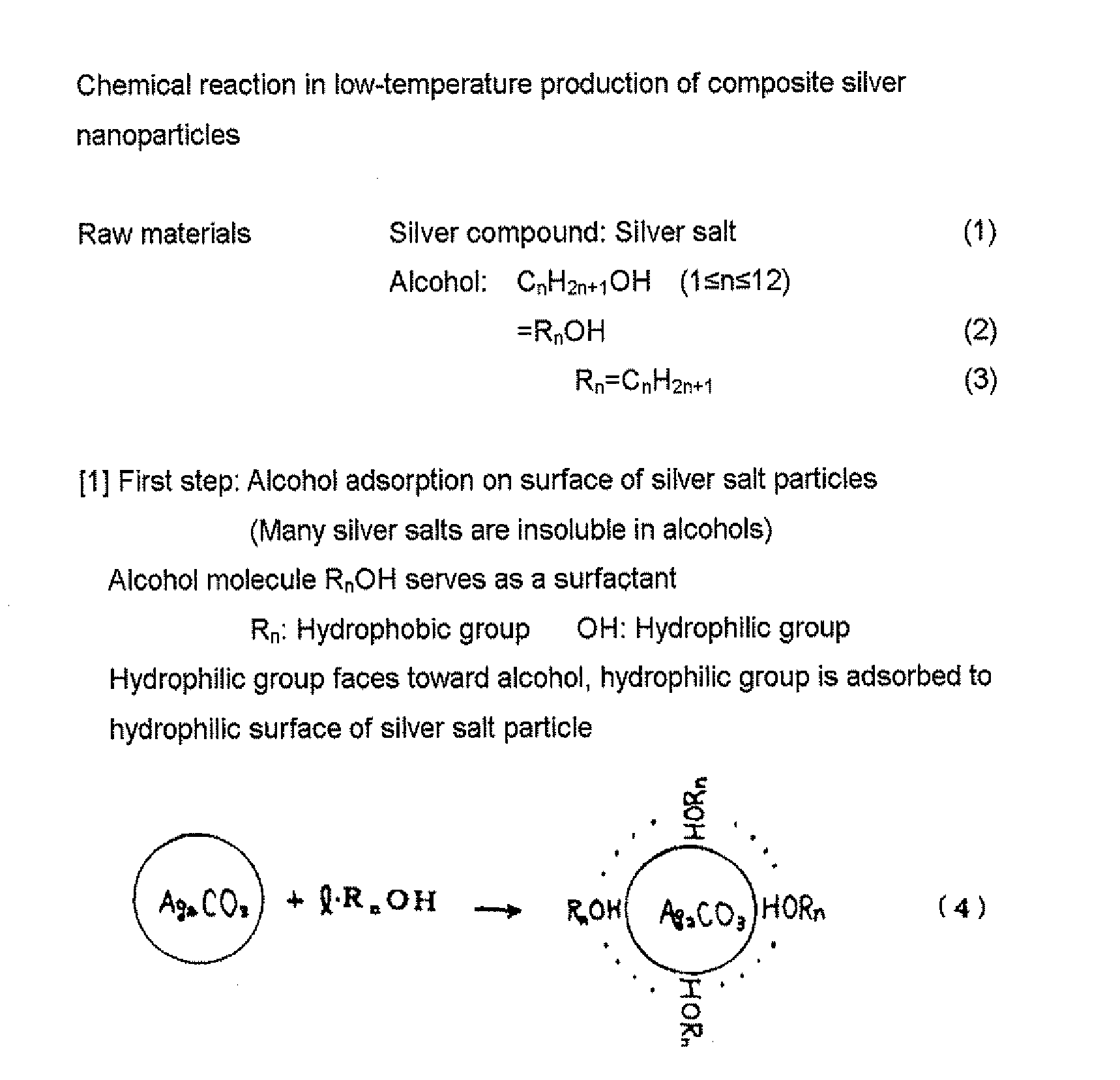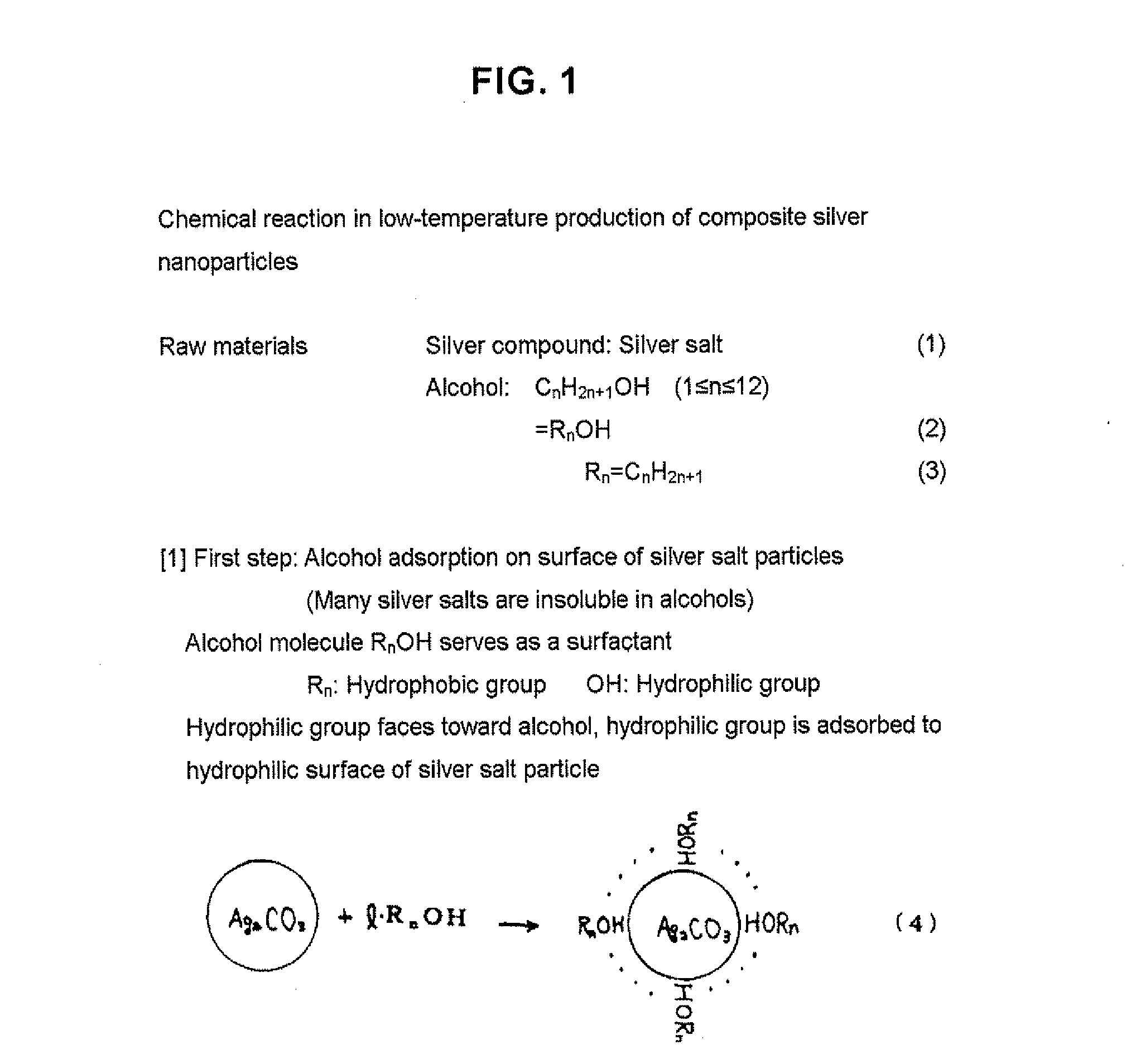[0055]According to the first form of the present invention, an
advantage is provided, in which the metal layer formed when a paste layer is sintered can be formed into a compact metal layer with few gaps, by composing the metallic components of nanometal paste from three types of metallic components of small, medium, and large, that is to say, from
small particles, medium particles, and large particles; filling the gaps between large particles with medium particles; and filling up the gaps between large particles and medium particles with
small particles. As a result, a metal layer joint having a high electric
conductivity,
high heat conductivity, and high
bond strength becomes possible. In particular, high
bond strength greater than or equal to 10 MPa is achieved. More specifically, it is composed from composite metal nanoparticles (metal core average particle diameter: X (nm)) that are the
small particles, metal nanofiller particles (metal average particle diameter: d (nm)) that are the medium particles, and metal filler particles (metal average particle diameter: D (nm)) that are the large particles, and the particle diameter conditions are set so that the first relation of X<d<D and the second relation of X<d<100 (nm) are satisfied. Because of this, the gaps between the metal filler particles can be filled with the metal nanofiller particles, and the remaining gaps can be filled with the composite metal nanoparticles. When it is put through a firing process, a compact metal layer nearly free of gaps can be realized. This metal layer can become a bonding metal layer for electronic components, semiconductors and such, and it can show good electrical and mechanical characteristics. Because the small particles are composed of composite metal nanoparticles, they monodisperse throughout the whole paste, move and are placed to fill the gaps, and form a compact metal layer upon firing. For said metal nanofiller particles, metal particles with an average particle diameter of less than or equal to 100 nm can be used, and composite metal nanoparticles having metal cores with an average particle diameter of less than or equal to 100 nm can also be used. When metal particles with an average particle diameter of less than or equal to 100 nm are hard to make by
machining or other
processing methods, composite metal nanoparticles in which the metal core is forcibly enlarged by a high temperature / long duration reaction can be used. Especially, since X, d, D are average particle diameters, particles smaller than those average particle diameters are contained in a large quantity. Because this group of extremely small particles become embedded into the gaps between the small, medium, and large particles, even more compact metal layer is formed.
[0056]According to the second form of the present invention, composite metal nanoparticles with a large diameter, in which an organic coating layer is formed on the circumference of the metal cores, are used as said metal nanofiller particles which are medium particles. Because of this, they can monodisperse throughout the whole paste, and easily enter the gaps between the metal filler particles. The organic coating layer of the composite metal nanoparticles composing the small and the medium particles gasify by firing, the metal filler particles and the metal cores of medium and small sizes move mutually and bond in the manner that they fill the gaps, which is effective in increasing the compactness of metal layer furthermore. For producing said composite metal nanoparticles which are the medium particles, if they are reacted at a high temperature for a long time, the particle diameter of the metal cores can be steeply increased, and it is advantageous in that it is possible to freely make the metal
core particle diameter throughout a range of 1 to several hundred nanometers. Among them, composite metal nanoparticles with average metal
core particle diameter of less than or equal to 100 nm, indicated by X<d<100 (nm), is selectively used in the present invention. Moreover, because the average particle diameters are X(nm) and d(nm), the particle diameters are distributed from small to large diameters in reality. The ultrafine particles distributed at smaller diameters enter the gaps of said large, medium, and small particles so that they are filled, and it becomes even more possible to form a compact metal layer. Therefore, it has an effect that it can freely form a metal layer of high electric conductivity, heat conductivity, and bond strength.
[0057]According to the third form of the present invention, average particle diameter d of said metal nanofiller particles has a size so that said metal nanofiller particles are inserted inside three pockets formed when three said metal filler particles are placed on a plane in a mutually contacting condition. Also, average particle diameter X of the metal cores of said composite metal nanoparticles has a size so that said metal cores of said composite metal nanoparticles are inserted inside gap of said metal filler particles and said metal nanofiller particles in said three pockets. That is to say, because average particle diameters X and d of the metal cores of the small and medium particles are set so that three pockets are filled under conditions that large particles are closest packed, a compact metal layer can be formed while the large, medium, and small particles move so that they mutually fill the gaps at the time of firing. Moreover, because D, d, X are average particle diameters, minute ultrafine particles are present in a large quantity. A metal layer is formed so that the group of these ultrafine particles fills the remaining gaps, and it became possible to maximally increase the compact degree of the metal layer. Therefore, it has an effect that it can freely form a metal layer of high electric conductivity, heat conductivity, and bond strength.
[0058]According to the fourth form of the present invention, a composite nanometal paste, whose said average particle diameters X, d, and D satisfy X≦[⅓−2 / {3(2√{square root over ( )}3−1)}]D and d≦(2 / √{square root over ( )}3−1)D, is offered. Average particle diameter X is the average particle diameter of the metal cores of composite metal nanoparticles (small particles), average particle diameter d is the average particle diameter of metal nanofiller particles (medium particles), and average particle diameter D is the average particle diameter of metal filler particles (large particles). When three large particles are placed so that they contact mutually (closest packed triangle placement), a three pocket (central gap) is formed in the center. It is proven that the diameter of a first inscribed circle placed in the three pocket so that it is inscribed in three said large particles becomes (2 / √{square root over ( )}3−1)D. Therefore, it is understood that when diameter d of a medium particle is smaller than the diameter of said inscribed circle, that is to say, when the condition equation of d≦(2 / √{square root over ( )}3−1)D is satisfied, the medium particle can be inserted into said three pocket. Furthermore, it is proven that the diameter of a second inscribed circle inscribed in a minute gap formed between said inscribed circle and three said large particles becomes [⅓−2 / {3(2√{square root over ( )}3−1)}]D. Therefore, it is understood that when diameter X of a
small particle is smaller than the diameter of said second inscribed circle, that is to say, when the condition equation of X [⅓−2 / {3(2√{square root over ( )}3−1)}]D is satisfied, the
small particle can be inserted into said minute gap. When the average particle diameters of the three particles of large, medium, and small size are set so that they satisfy these two conditions, the metal layer formed by firing easily comprise the closest packing structure, and even if it is not closest packed, the structure easily becomes close to the closest packed structure. Therefore, there is an
advantage that a compact metal layer can be formed. As a result, it has an effect that it can freely form a metal layer of high electric conductivity, heat conductivity, and bond strength. Moreover, because D, d, X are average particle diameters, minute ultrafine particles are present in a large quantity. A metal layer is formed so that the group of these ultrafine particles fills the remaining gaps, and it became possible to maximally increase the compact degree of the metal layer.
[0059]According to the fifth form of the present invention, a composite nanometal paste, to which a solvent and / or a
viscosity imparting agent is added, can be provided. Said solvent is a material that disperses and makes a solution out of three metallic component particles used in the present invention, and for example,
alcohol,
acetone,
toluene,
xylene,
propanol,
ether,
petroleum ether,
benzene and such can be used. Said
viscosity imparting agent is a material that is added to said solution and imparts
viscosity so that it becomes easy to apply, and for example, oil of
turpentine,
terpineol,
methyl cellulose,
ethyl cellulose, butylal, various
terpene derivatives, IBCH (isobornyl
cyclohexanol), glycerin, and an
alcohol longer than or equal to C14 that is
solid at
room temperature can be used, among others. For
terpene derivative, there are 1,8-terpine monoacetate and 1,8-terpine diacetate. IBCH is
rosin-like, glycerin is syrup-like, and an
alcohol longer than or equal to C14 has a property to change between
solid and liquid states, and is non-fluid at 10° C. When three metallic component particles of the present invention are mixed and dispersed in said non-
fluid viscosity imparting agent to form a non-fluid paste, an aggregation between the three metallic component particles does not occur, because the composite silver nanoparticles are fixed in a dispersed state at a low temperature of less than or equal to 10° C. If said non-fluid paste is heated just before use, it becomes fluid and becomes possible to be applied as a paste, so that it can achieve a function as a paste. Also, needless to say, if said solvent is added to said non-fluid paste just before use, it becomes a fluid paste even without heating, so that it can achieve a function as a paste.
[0060]In a composite nanometal paste of the present invention, it is desirable that the evaporating temperature or the
decomposition temperature of said solvent and / or viscosity imparting agent is as low as possible. Therefore, the firing temperature of a paste is decided not only by the metalization temperature of the composite
silver nanoparticle, but it also depends on the evaporating temperature or the
decomposition temperature of the solvent and the viscosity imparting agent. Also, it is necessary for it to gasify by
evaporation or
decomposition through an application of heat, and materials that carbonize and remain are excluded. Also, as usage embodiments, a paste to which only solvent has been added, a paste to which only viscosity imparting agent has been added, and a paste to which both solvent and viscosity imparting agent have been added, can be used.
 Login to View More
Login to View More 


